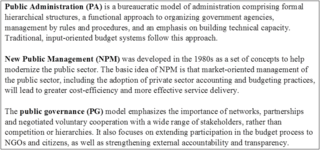Posted by Johann Seiwald1
Since the late 1980s, many governments have moved away from traditional Public Administration (PA) systems – which highlight the importance of hierarchy, legal rules, and a clear division of labor within the administrative system - in favor of the New Public Management (NPM) model. More recently, a new “Public Governance” (PG) model has emerged which emphasizes concepts and values such as accountability, transparency and participation (see box below). One model does not necessarily supplant the others. In some countries, elements of all three models coexist, and can complement each other.
These models of public administration were examined in a recent paper2 that evaluates public sector accounting and budgeting reforms in three countries (Austria, Italy and the U.K.) and the arguments put forward by the governments concerned to support the changes in their PFM laws and practices. The paper investigates:
(a) to what extent the PFM reforms carried out in the three countries were supported by arguments based on the concepts and principles of PA, NPM or PG (“the talk”);
(b) how these discussions were incorporated into the countries’ PFM laws (“the walk”);
(c) whether over time there has been any change in the complexion of the reforms in terms of their PA/NPM/PG categorization (“the path”); and
(d) to what extent changes in the PFM laws have been aligned to the discussion in public documents and in the legislature about the reforms of budgeting and accounting (“the match”).
To assess whether reform in the three countries has followed a PA, NPM or PG approach, the paper sets out a methodology that analyzes key words used in political debates and legal documents relating to budgeting and accounting reforms during a 30-year period (1980-2011). Examples of key words used in the study include bureaucracy, rules/norms/requirements, compliance, hierarchy, procedures (under PA); efficiency, effectiveness, indicators/targets, performance, market orientation (under NPM); and governance, transparency, stakeholder, partnership and participation (under PG). The main sources of data included approved laws and regulations, technical commentaries prepared by government officials on draft bills, and debates in parliamentary chambers and committees. The study analyzed a few thousand pages of relevant documents and used a computer software system (ATLAS.ti.6) to help with the coding and analysis.
The analysis yielded some interesting results:
• In the United Kingdom, NPM-oriented reforms such as the introduction of accrual budgeting and performance management systems dominated public debate over the three decades.
• In Italy, traditional public administration (PA) reforms were dominant for most of the period, although with some NPM features – for example the introduction of cost accounting and performance measurement in 1997 and 2007 – also noticeable. Such NPM-influenced changes, however, were irregular in their timing and not strongly embedded in the overall system.
• In Austria, the overall picture was mixed. The debate was clearly still PA-oriented in the 1980s, with a significant move towards NPM ideas in the 1990s. At this time, however, the accounting and budgeting systems still displayed largely traditional PA-type features. The extensive reforms of public finance initiated in 2009 suggest an attempt by the government to maintain elements of the bureaucratic basis of public administration, while integrating NPM and PG features into the system.
The study finds that in all three countries NPM and PG concepts have enriched the discussion of budget and accounting reforms, adding new layers to the public debate (“sedimentation”). Each country made its own specific translation of these ideas and concepts and the process of sedimentation has proceeded at varying speeds. The study also suggests that the sedimentation process has influenced the timing of the reforms in the countries concerned. As a consequence, the UK reforms have proceeded quite rapidly, while in Austria and Italy, traditionally characterized by more formalized and bureaucratic public management systems, the governments have required more time and effort to align the views of stakeholders, and build a consensus for reform. From a practical point of view, the study highlights the importance of carrying out a thorough analysis of the institutional, political and cultural context of the existing budgeting and accounting systems, as well as the process of communicating information to politicians and other stakeholders, when proposals to reform these systems are being considered.
1 Johann Seiwald is a Technical Assistance Advisor in FAD. Before joining the Fund, Johann was the Head of the Austrian Performance Management Office and Senior Advisor at the Ministry of Finance, where he was part of the development team of the budget reform and implemented the performance budgeting and management system in Austria.
2 Hyndman, Noel, Liguori, Mariannunziata, Meyer, Renate, Polzer, Tobias, Rota, Silvia, and Seiwald, Johann. “The Translation and Sedimentation of Accounting Reforms. A Comparison of the UK, Austrian and Italian Experiences”. Critical Perspectives on Accounting, 2013. The paper can be downloaded at http://www.sciencedirect.com/science/article/pii/S1045235413000646.
Note: The posts on the IMF PFM Blog should not be reported as representing the views of the IMF. The views expressed are those of the authors and do not necessarily represent those of the IMF or IMF policy.









